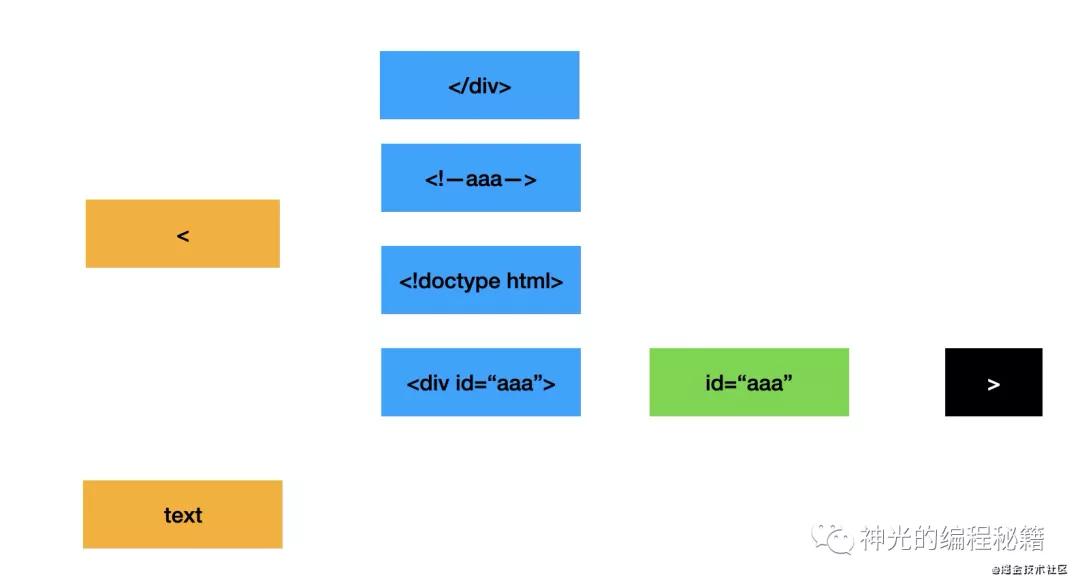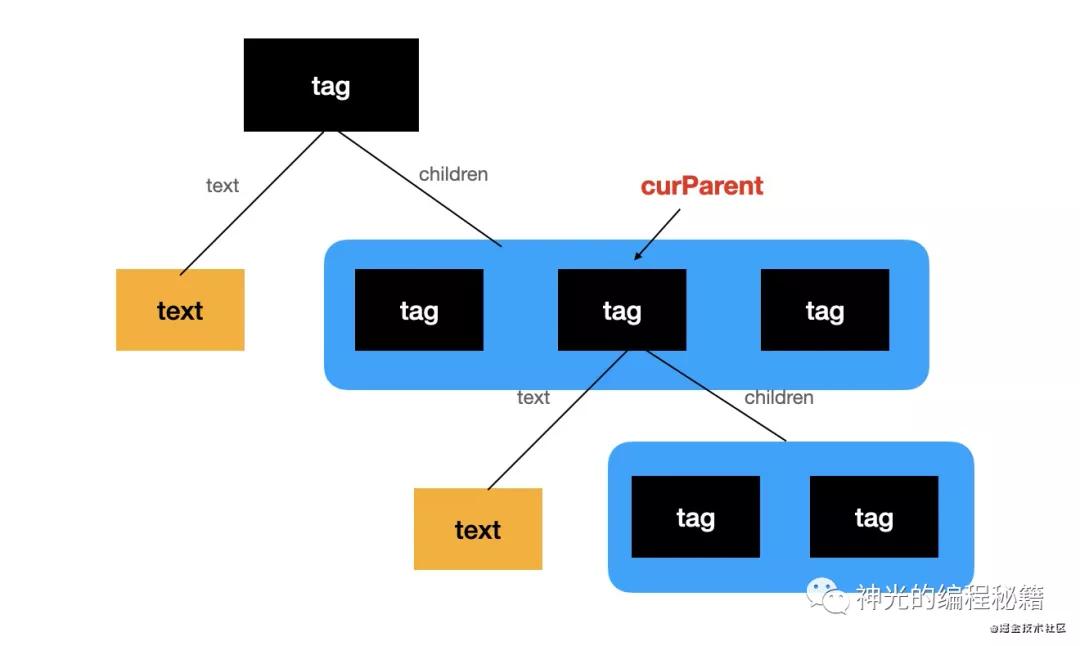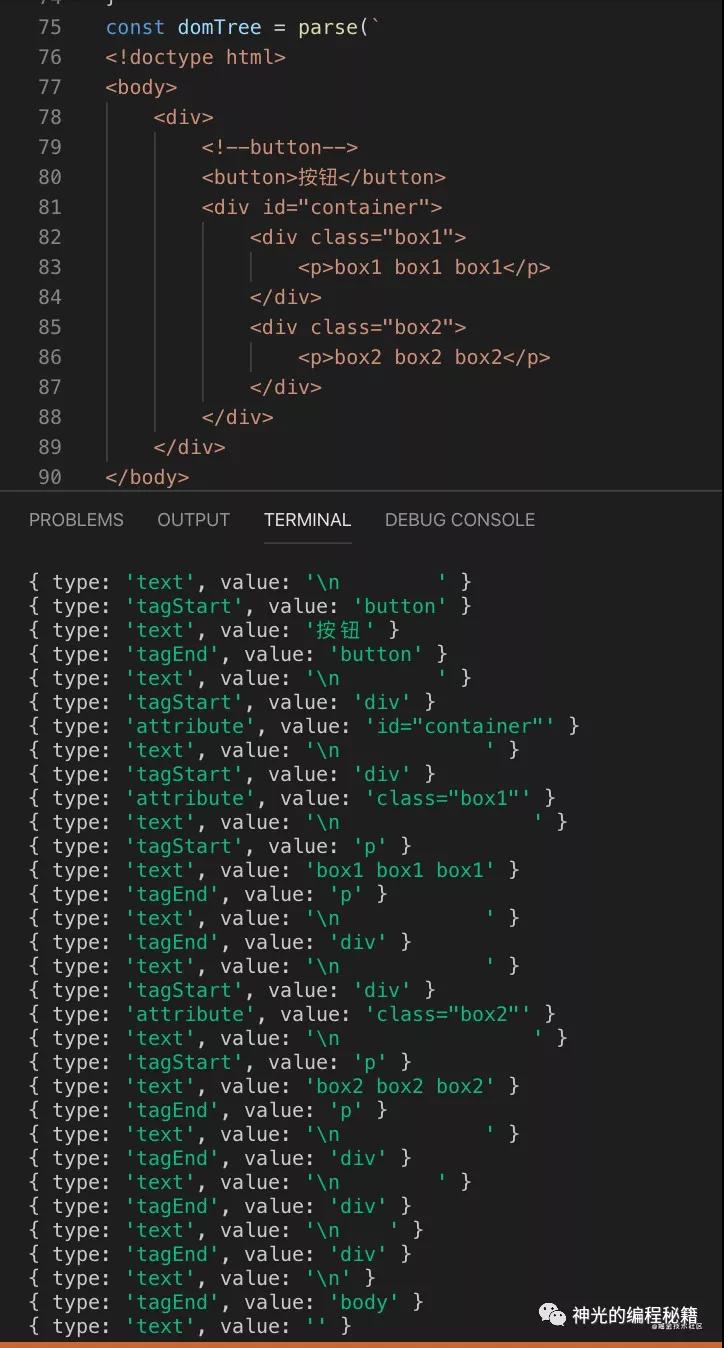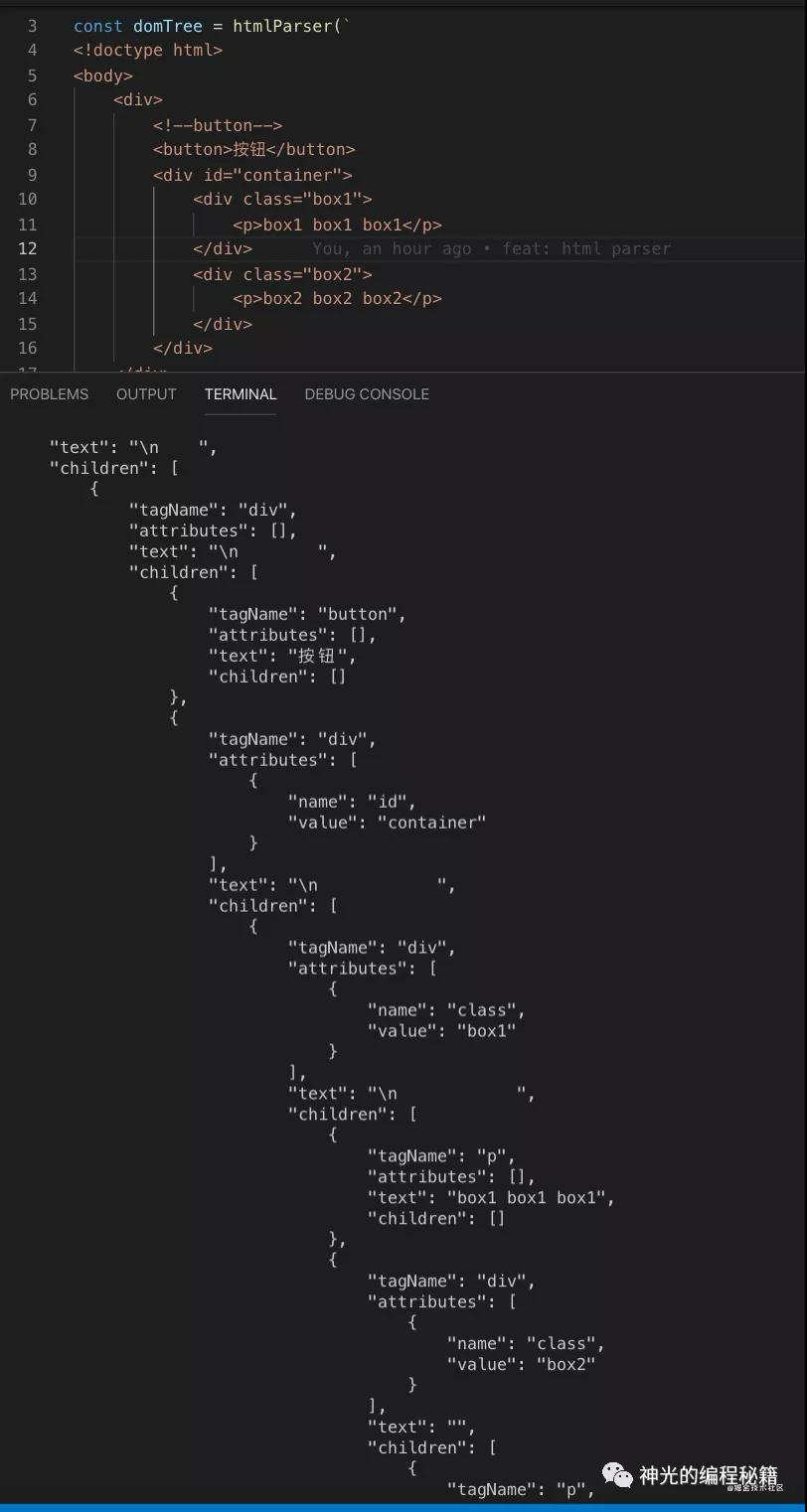本文转载自微信公众号「神光的编程秘籍」,作者神说要有光zxg。转载本文请联系神光的编程秘籍公众号。
思路分析
实现 html parser 主要分为词法分析和语法分析两步。
词法分析
词法分析需要把每一种类型的 token 识别出来,具体的类型有:
- 开始标签,如 <div>
- 结束标签,如 </div>
- 注释标签,如 <!--comment-->
- doctype 标签,如 <!doctype html>
- text,如 aaa
这是最外层的 token,开始标签内部还要分出属性,如 id="aaa" 这种。
也就是有这几种情况:
第一层判断是否包含 <,如果不包含则是 text,如果包含则再判断是哪一种,如果是开始标签,还要对其内容再取属性,直到遇到 > 就重新判断。
语法分析
语法分析就是对上面分出的 token 进行组装,生成 ast。
html 的 ast 的组装主要是考虑父子关系,记录当前的 parent,然后 text、children 都设置到当前 parent 上。
我们来用代码实现一下:
代码实现
词法分析
首先,我们要把 startTag、endTag、comment、docType 还有 attribute 的正则表达式写出来:
正则
结束标签就是
- const endTagReg = /^<\/([a-zA-Z0-9\-]+)>/;
注释标签是 中间夹着非 --> 字符出现任意次
- const commentReg = /^<!\-\-[^(-->)]*\-\->/;
doctype 标签是 字符出现多次,加 >
- const docTypeReg = /^<!doctype [^>]+>/;
attribute 是多个空格开始,加 a-zA-Z0-9 或 - 出现多次,接一个 =,之后是非 > 字符出多次
- const attributeReg = /^(?:[ ]+([a-zA-Z0-9\-]+=[^>]+))/;
开始标签是 < 开头,接 a-zA-Z0-9 和 - 出现多次,然后是属性的正则,最后是 > 结尾
- const startTagReg = /^<([a-zA-Z0-9\-]+)(?:([ ]+[a-zA-Z0-9\-]+=[^> ]+))*>/;
分词
之后,我们就可以基于这些正则来分词,第一层处理 < 和 text:
- function parse(html, options) {
- function advance(num) {
- html = html.slice(num);
- }
- while(html){
- if(html.startsWith('<')) {
- //...
- } else {
- let textEndIndex = html.indexOf('<');
- options.onText({
- type: 'text',
- value: html.slice(0, textEndIndex)
- });
- textEndIndex = textEndIndex === -1 ? html.length: textEndIndex;
- advance(textEndIndex);
- }
- }
- }
第二层处理 <!-- 和 <!doctype 和结束标签、开始标签:
- const commentMatch = html.match(commentReg);
- if (commentMatch) {
- options.onComment({
- type: 'comment',
- value: commentMatch[0]
- })
- advance(commentMatch[0].length);
- continue;
- }
- const docTypeMatch = html.match(docTypeReg);
- if (docTypeMatch) {
- options.onDoctype({
- type: 'docType',
- value: docTypeMatch[0]
- });
- advance(docTypeMatch[0].length);
- continue;
- }
- const endTagMatch = html.match(endTagReg);
- if (endTagMatch) {
- options.onEndTag({
- type: 'tagEnd',
- value: endTagMatch[1]
- });
- advance(endTagMatch[0].length);
- continue;
- }
- const startTagMatch = html.match(startTagReg);
- if(startTagMatch) {
- options.onStartTag({
- type: 'tagStart',
- value: startTagMatch[1]
- });
- advance(startTagMatch[1].length + 1);
- let attributeMath;
- while(attributeMath = html.match(attributeReg)) {
- options.onAttribute({
- type: 'attribute',
- value: attributeMath[1]
- });
- advance(attributeMath[0].length);
- }
- advance(1);
- continue;
- }
经过词法分析,我们能拿到所有的 token:
语法分析
token 拆分之后,我们需要再把这些 token 组装在一起,只处理 startTag、endTag 和 text 节点。通过 currentParent 记录当前 tag。
- startTag 创建 AST,挂到 currentParent 的 children 上,然后 currentParent 变成新创建的 tag
- endTag 的时候把 currentParent 设置为当前 tag 的 parent
- text 也挂到 currentParent 上
- function htmlParser(str) {
- const ast = {
- children: []
- };
- let curParent = ast;
- let prevParent = null;
- const domTree = parse(str,{
- onComment(node) {
- },
- onStartTag(token) {
- const tag = {
- tagName: token.value,
- attributes: [],
- text: '',
- children: []
- };
- curParent.children.push(tag);
- prevParent = curParent;
- curParent = tag;
- },
- onAttribute(token) {
- const [ name, value ] = token.value.split('=');
- curParent.attributes.push({
- name,
- value: value.replace(/^['"]/, '').replace(/['"]$/, '')
- });
- },
- onEndTag(token) {
- curParent = prevParent;
- },
- onDoctype(token) {
- },
- onText(token) {
- curParent.text = token.value;
- }
- });
- return ast.children[0];
- }
我们试一下效果:
- const htmlParser = require('./htmlParser');
- const domTree = htmlParser(`
- <!doctype html>
- <body>
- <div>
- <!--button-->
- <button>按钮</button>
- <div id="container">
- <div class="box1">
- <p>box1 box1 box1</p>
- </div>
- <div class="box2">
- <p>box2 box2 box2</p>
- </div>
- </div>
- </div>
- </body>
- `);
- console.log(JSON.stringify(domTree, null, 4));
成功生成了正确的 AST。
总结
这篇是简易浏览器中 html parser 的实现,少了自闭合标签的处理,就是差一个 if else,后面会补上。
我们分析了思路并进行了实现:通过正则来进行 token 的拆分,把拆出的 token 通过回调函数暴露出去,之后进行 AST 的组装,需要记录当前的 parent,来生成父子关系正确的 AST。
html parser 其实也是淘系前端的多年不变的面试题之一,而且 vue template compiler 还有 jsx 的 parser 也会用到类似的思路。还是有必要掌握的。希望本文能帮大家理清思路。
代码在 github:https://github.com/QuarkGluonPlasma/tiny-browser































